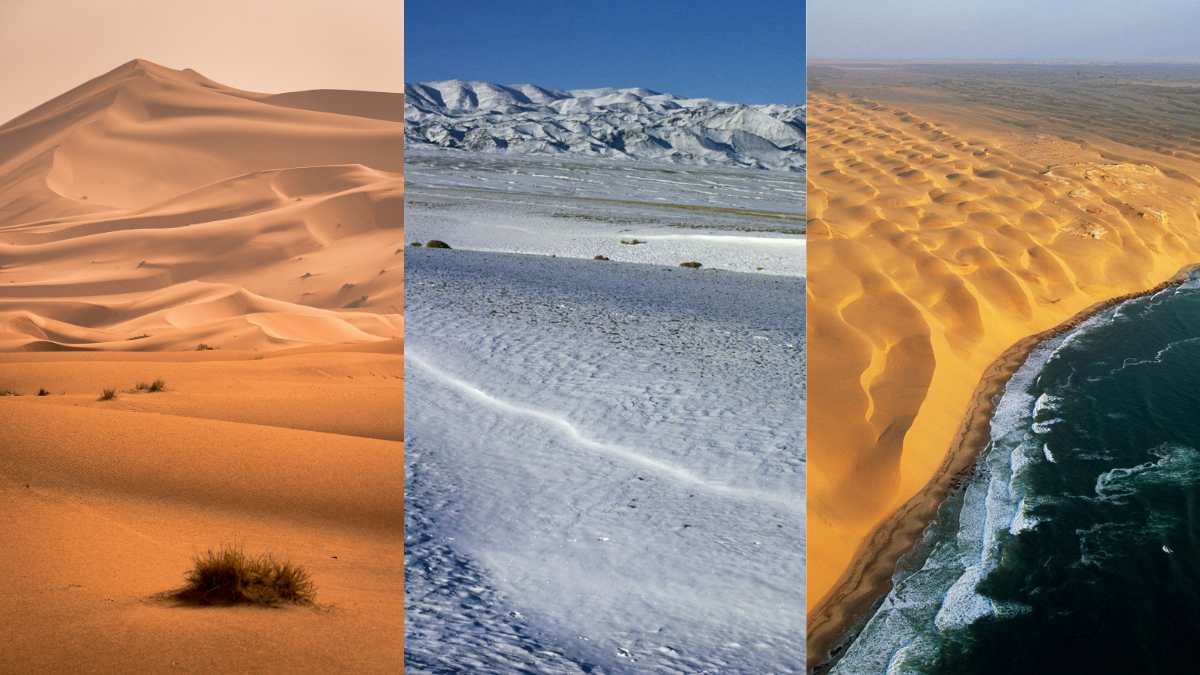Nearly one-third of Earth’s entire land surface is classified as desert. There are several types of deserts, and although many believe that nothing grows or survives in a desert, that is not entirely true. Many civilizations, including some of the oldest and greatest, originated in deserts.
There is a desert on every continent. They may not offer the most attractive habitat or the most picturesque landscape, but deserts play an important environmental role and are home to a variety of unique plants and animals. Therefore, it becomes essential to know the deserts, their types, formation and habitat.
What is a desert?
A desert is any place that receives extremely low rainfall and is dry and inhospitable. The stereotypical image of endless sand dunes, camels and palm trees is what comes to mind when most people think of deserts. But these are only the characteristics of hot deserts like the Sahara and the Kalahari.
Deserts are not only scorching; They can also be cold. In fact, many deserts have sub-zero temperatures and are covered in ice, such as the Antarctic and Arctic deserts. Low rainfall is the main characteristic of a desert.
How are deserts formed?
The formation of deserts is a long process that develops over centuries. It begins with low rainfall and erosion, which over time causes desertification. Erosion of rocks due to drastic changes in day and night temperatures degrades them.
The Sahara used to be a lush, green farmland thousands of years ago. But due to Earth’s orbital change, the monsoons decreased and temperatures began to fluctuate. The progressive decrease in favorable environmental conditions caused the loss of vegetation and the formation of deserts in the Sahara.
Similarly, other deserts like the Ladakh Desert were formed due to the nearby mountain ranges, the Himalayas blocking the air carrying moisture.
Types of deserts
There are five main types of deserts, each with unique characteristics and origins.
1. Tropical desert
At the equator, the air is hot, so it moves toward the poles on both sides, pushing away clouds. Hot, moist air cools as it rises and drops moisture as rain. After that, the air descends and warms up again. This usually occurs near the Tropic of Cancer and gives rise to subtropical deserts such as the Sahara, Kalahari and Tanami.
2. Coastal desert
Coastal deserts like the Atacama in Chile form when cold sea air loses all moisture before reaching the coast, and the region receives little or no rain, becoming a desert.
3. Rain Shadow Desert
Then there are rain shadow deserts, like Death Valley in the US, which form when air rises toward a mountain range but cannot cross it; the air loses its humidity and descends towards the leeward slopes. But it is hot again and does not allow clouds to form or rain.
4. Inland desert
Interior deserts such as the Gobi Desert form in deep, unreachable places, far from the coast and surrounded by mountains or other obstacles that cause little rainfall. The winds lose all their moisture when they reach these places and, over time, this results in the formation of deserts.
5. Polar desert
Polar deserts, as their name suggests, are located at the poles of the Earth. The Arctic and Antarctica are also classified as deserts because they are arid and do not receive much precipitation. Although they contain almost all of the fresh water on the planet, most of it is frozen and unavailable to plants and animals.
Read also: What is gaslighting? Definition, warning signs and how to deal with them
Read also: Fact or fiction: the Sahara is the largest desert in the world
Categories: Optical Illusion
Source: ptivs2.edu.vn
